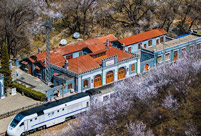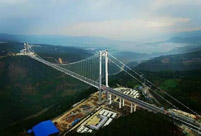


Crew members at a regional division of CRC in Chengdu, capital of Sichuan province, take part in a rescue exercise. [Wang Zhengwei/China Daily]
The company should be divided into several firms, expert says
Mounting debts at State-owned China Railway Corp Group have sparked calls to split up the country's main railway service provider. A railway expert said on Friday the central government should divide the CRC into several regional companies with a shareholding structure to maintain a healthy growth.
Total liabilities of the CRC stood at 4.14 trillion yuan ($636.73 billion) by the first quarter of this year. The company had a deficit of 8.73 billion yuan between January and March of 2016, up 35 percent on a year-on-year basis, according to the CRC's audit report for the first quarter of 2016.
The company said in an announcement that the losses during this period were mainly caused by fast-growing road transportation and an overall decline in rail goods transportation.
Luo Renjian, with the Institute of Transport Research at the National Development and Reform Commission, said even though the CRC's debt burden was not high compared with firms in sectors such as highways, civil aviation and ports, it would be better to divide the company.
"It would effectively save cost and even make profit to divide the current CRC system into several regional companies with proper shareholding structure to optimize the country's railway service resources and networks," said Luo.
CRC declined to comment on the issue on Friday.
Eager to restore its earning ability, the CRC announced last month the creation of a number of rail logistics centers in Anhui and Shandong provinces to support transportation of household appliances and diversify its businesses, an effort to compete with airlines and private delivery companies.
As China's main railway network developer, the CRC is also responsible for investments in big-ticket projects like railway construction and the purchase of equipment including bullet and freight trains.
The government has an investment target of more than 800 billion yuan for railway construction to expand China's high-speed railway network this year, build more intercity and city-suburb links, and work to complete a freight railway network.
Zhao Jian, a professor of rail logistics at Beijing Jiaotong University, said because of its administrative role, the CRC has no choice but continue to invest in these new projects. Therefore, gaining loans from both policy and commercial banks, and issuing bonds to raise capital for railway construction are only solutions for it to gain the cash.
"Introducing a public-private partnership model or forming joint ventures certainly can help the CRC reduce spending on public transport services, optimize work efficiency, and bring more conveniences to passengers and company clients," said Zhao.
The PPP model is where a government service or private business venture is funded and operated through a partnership of government and one or more companies from private sector.
According to a recent announcement by the NDRC, China's top economic planning agency, the CRC is being empowered to decide how much high-speed train tickets cost in light of "market competition and passenger distribution".
Previously, the price was set by the commission itself.
"This move should be welcomed. As a company in a market economy, the CRC should be free from the shackles of administrative intervention. Only by doing so can it make the best use of resources, raise efficiency, improve profits and better serve passengers," said Zhou Zhicheng, deputy director for research at the Beijing-based China Federation of Logistics and Purchasing.
China has more than 121,000 kilometers of rail lines in operation. More than 19,000 km of them are high-speed railways, accounting for more than 60 percent of the total in the world.
 Beijing Style: ready for bare legs
Beijing Style: ready for bare legs Century-old station sees railyway evolution
Century-old station sees railyway evolution Amazing scenery of Xisha Islands
Amazing scenery of Xisha Islands Enthusiasts perform Kung Fu at Wudang Mountain
Enthusiasts perform Kung Fu at Wudang Mountain Stunning photos of China's fighter jets in drill
Stunning photos of China's fighter jets in drill Monk's mummified body to be made into a gold Buddha statue
Monk's mummified body to be made into a gold Buddha statue Asia's longest and highest suspension bridge to open to traffic
Asia's longest and highest suspension bridge to open to traffic China's first interactive robot looks like a beauty
China's first interactive robot looks like a beauty Vietnamese Su-30 fighters fly over Nanwei Island in South China Sea
Vietnamese Su-30 fighters fly over Nanwei Island in South China Sea Top 20 hottest women in the world in 2014
Top 20 hottest women in the world in 2014 Top 10 hardest languages to learn
Top 10 hardest languages to learn 10 Chinese female stars with most beautiful faces
10 Chinese female stars with most beautiful faces China’s Top 10 Unique Bridges, Highways and Roads
China’s Top 10 Unique Bridges, Highways and Roads Unpredictable Trump could swing either way on China
Unpredictable Trump could swing either way on China Military institution scandal highlights shady Putianese private clinics
Military institution scandal highlights shady Putianese private clinics How to maintain property in communist system looms large as land warrants expire
How to maintain property in communist system looms large as land warrants expire Yiwu, China’s wholesale capital, switches its economic growth engine from manufacturing to design
Yiwu, China’s wholesale capital, switches its economic growth engine from manufacturing to designDay|Week